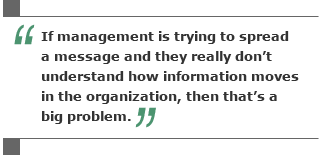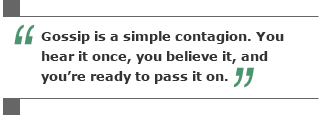Though many of us may think of mathematicians as cold-blooded, hard-eyed number crunchers, in actuality, they're mysteriously thrilling. Don't believe it? Step into Jon Kleinberg's classroom at Cornell University. You might arrive on the day an impassioned -- and anonymous -- undergraduate student makes an impromptu visit to shout "Kleinberg is Rebel King!" before escaping under cover of vociferous applause.
 |
Kleinberg's appeal in his professional circle is much less mysterious, but just as passionate. He's a professor of computer science at Cornell University and the author of many prominent papers and articles, as well as a textbook titled Algorithm Design. He's received awards and fellowships from the National Science Foundation, the MacArthur Foundation, the Packard Foundation, the Sloan Foundation, and the Office of Naval Research. Kleinberg was also the 2006 recipient of the Rolf Nevanlinna Prize, considered by many to be the Nobel Prize of computer science. (See "Rolf Nevanlinna Prize" in the "See Also" area on this page.)
But the value Jon Kleinberg provides to the business community is based on his approach to solving a particularly profitable mystery: how information, ideas, and real and virtual communities form, spread, and thrive. Kleinberg's research centers on algorithmic issues at the interface of networks and information, with an emphasis on the social and information networks that underpin the Web and other online media. In other words, Kleinberg can map the invisible world of information sprawl.
That's a heady notion in an information economy, especially considering the fortunes to be made on the Internet -- and fortunes to be lost when the wrong information reaches the wrong people. In this interview, Dr. Kleinberg discusses how to control the spread of information, how to design viral marketing that works, why Web sites like MySpace are so successful, how to send out feelers during succession planning, and even how to nip office gossip in the bud.
GMJ: Does viral marketing work?
Dr. Kleinberg: It's clear [from the study of] groups or new behaviors or new practices or new technologies that the simple use of them encourages adoption of them. Seeing a new thing used is a powerful thing.
A great example is when Microsoft introduced Hotmail as free Web-based e-mail. That's one of the earliest success stories of viral marketing, which is a kind of recruitment; in this case, people recruited into the Hotmail community. Hotmail is an example of a technology that by its very use, it made people aware of it. The use of technology actively advertises it, and that's something that tends to attract members very quickly.
GMJ: But viral marketing is a tricky thing; there have been many more failures than successes. How does a company make it work?
Kleinberg: I think there's a lot of potential to viral marketing, but it's clear that if you want something to spread widely, you need to design incentives very carefully. It's easy to make up things that could be called viral marketing that simply won't cause the product to catch on once you actually try it out in the world. And there are some patterns that we're seeing in group formation; these recurring themes might end up telling us something about this.
GMJ: Such as?
Kleinberg: One is the power of the second friend. Namely, the probability of you joining a community or buying something or doing something is very low if you have one friend who has done it. However, your probability of doing the same goes up dramatically if you have two friends joining or buying or doing something. Then after the third, fourth, and fifth friend join, your probability starts to taper off.
So the biggest single gain in your likelihood of doing something is when the second person you're connected to does it. If one friend does something, he might be doing it for his own reasons, but somehow once you have two, then you start to see trends or patterns.
There are all sorts of ways in which we can try interpreting what this means, but it's a phenomenon that's now shown up in a number of different domains -- in people joining online communities, in the spread of ideas in professional communities, and in marketing settings like online purchases. And, at least in the setting of joining online communities, which we've studied, if you have three friends in an online community, and they are all friends, you're much more likely to join than if they are not friends.
GMJ: How do you work that? Say that I'm thinking about launching a Web site like MySpace, where I'll let people upload pictures and e-mail friends. I'd need people to visit and form a community -- but once I've roped in my friends, how would I recruit others?
Kleinberg: If you were looking at a setting like that, the hard part is that you don't get to run the experiment first and see what happens. Because when you're trying to create a community, you can ask, "What kinds of communities that we have studied does this most resemble?" Yours would be more of a hanging-out-online community, not a feeding-you-information community.
 |
So you'll want to seed this so that people are drawn in by multiple, well-connected friends in the community. People will want to see multiple friends join before they do, so you don't want to seed it with a bunch of far-flung people in a social network -- it somehow might not gel, and there might not be enough critical mass in any one place. But if you pick a few well-connected bunches of people, they'll have multiple friends in that same group who'll be drawn in, and the thing might spread from there.
If you wanted to start something that was more informational in nature, or if you wanted to spread the word about something, then you might do the opposite. You start spreading the word in many independent places and try to let it coalesce around people.
GMJ: Speaking of, how do information cascades work in business?
Kleinberg: We certainly don't understand all the factors that go into what makes [information cascades] successful or not. But it is clear that the set of people in the organization who buy into a message early on matters a lot.
An effective technique for spreading the message is to pass it on to people who are well-connected in the organization and who also span different communities. And any person's chance of believing something or adopting some new behavior increases as they see more and more of their friends and contacts do it.
So you have to triangulate your way to the goal. It's not enough to simply spread this thing out like a virus and have each person catch it once. Social contagion is much more complex, and in order to believe the message, you may need to see it from multiple independent sources.
GMJ: What if the information is that a major change is afoot? Say your company is no longer publishing books, and it's going to make movies instead. Is it better to tell the executive team and have them tell their underlings, who'll tell theirs, and so on? Or should you have an all-hands meeting?
Kleinberg: This may sound like a copout answer, but a combination of strategies is important. Because the key question is: What is it that people need to see in order to believe the message? They must have heard the message, but they also must believe that everyone else has heard the message too. And they must believe that everyone has bought into the message. If you just hear the message, even though everyone else has heard it, if you don't believe other people are going to act on it, then somehow you don't have as much reason to act on it either.
So different techniques may be necessary to achieve different goals. For example, an all-hands meeting makes everyone aware that everyone has heard the message. And that's an important step. But to get people to believe that others are actually buying into the message, you also want to concurrently push it through the informal social network among the employees.
GMJ: How do you do that?
Kleinberg: You try to find someone, or maybe a few people, who believe in the message and who are trusted by the rest of the employees -- like an early-adopter group for the message. In any organization, management has some sense of what roles people play, even informally, and that's going to be important. But if management is trying to spread a message and they really don't understand any of the actual ways in which information moves in the organization, then that's an even bigger problem, and it needs to be addressed independently of getting this particular message out.
But if management understands what things look like structurally, then they know that certain people are very good at bridging different groups within the organization. And if you want to get a message out quickly to different people, you need to get those people -- the people who have "preaching" roles -- to buy into the message, because they can spread things to different groups. But if they don't buy into the message, they can also be obstacles to spreading information.
GMJ: What about very subtle messages, such as those made by executives doing succession planning?
Kleinberg: For certain messages, it's very important for people to believe that they are bottom-up messages, not top-down. People will respond differently if they think the message is organic -- if they think the support for a successor is latent in the organization and it's not being pushed from the top down. You want to get buy-in from a few people, and you want to do it without making a big show of it. If that can spread organically, then it gives employees a sense that there was a bottom-up feeling for this rather than top-down.
 |
An all-hands meeting for this kind of thing would be counterproductive. If you're afraid that there's a lack of direction, and you want to know that everyone has heard this message, have an all-hands meeting. But if you want people to accept it as a bottom-up activity, starting with the informal social network might be more effective.
GMJ: What's the difference between an information cascade and gossip? Intra-organization gossip can be terribly destructive.
Kleinberg: Both gossip and information cascades are socially contagious processes. As you see your friends and colleagues do something, you start to do it or believe it. Gossip is on the extreme of the spectrum. It doesn't require any thinking -- as soon as you hear something, you know the gossip too. It just sort of spreads like wildfire.
An information cascade involves some actual judgment; people must believe the information. Saying or doing something once may not be enough -- you have to triangulate, you have to find multiple ways of reaching each person so that they see it as something that many of their friends are doing. Information cascades are a more complex contagion in which you need to see several people you care about doing [an activity], whether those people are independent sources or correlated sources.
GMJ: So how do you deal with inaccurate or destructive gossip?
Kleinberg: Gossip is a simple contagion. You hear it once, you believe it, and you're ready to pass it on. Gossip comes to you in the same way that you contract a cold -- you get it from one person, and then you're ready to pass it on to more people. With simple contagions, once they're under way, they're very hard to contain. Once a whole bunch of people know something, and it's spreading like wildfire, you can't contain it at the boundary, because the boundary is growing too rapidly.
So to stamp out the contagion, you have two choices. You can either work really hard to contain it immediately because the very early stages are very, very important -- once it spreads, it's impossible to stamp it out. You stamp it out here, but it's still growing over there.
But the other thing you can do is change it from a simple contagion to a complex contagion. Initially, the message spread like pure gossip: Someone heard it once, then told two friends about it. If you can convert the gossip into something that people are more hesitant to believe, such as information that people need independent channels to confirm, then you can slow the spread of it even after it's already out. For example, you can change the meaning that people impute to the gossip so that it spreads more slowly and is less believable.
GMJ: Okay, what's the deal with the "Rebel King"?
Kleinberg: Well, "Rebel King" is an anagram of my last name. In a strange way, it relates to what we've talked about -- it's come about because of the social network of computer science students at Cornell, and it's lasted longer than the four-year career of any student at Cornell. But why they do it is a mystery to me.
-- Interviewed by Jennifer Robison